Related Research Articles
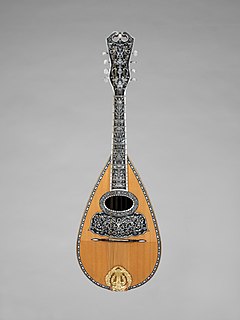
A mandolin is a stringed musical instrument in the lute family and is generally plucked with a plectrum. It most commonly has four courses of doubled metal strings tuned in unison, thus giving a total of 8 strings, although five and six course versions also exist. The courses are typically tuned in an interval of perfect fifths, with the same tuning as a violin. Also, like the violin, it is the soprano member of a family that includes the mandola, octave mandolin, mandocello and mandobass.

The violin, sometimes known as a fiddle, is a wooden chordophone in the violin family. Most violins have a hollow wooden body. It is the smallest and thus highest-pitched instrument (soprano) in the family in regular use. The violin typically has four strings, usually tuned in perfect fifths with notes G3, D4, A4, E5, and is most commonly played by drawing a bow across its strings. It can also be played by plucking the strings with the fingers (pizzicato) and, in specialized cases, by striking the strings with the wooden side of the bow.

String instruments, stringed instruments, or chordophones are musical instruments that produce sound from vibrating strings when a performer plays or sounds the strings in some manner.

The bouzouki, also spelled buzuki or buzuci, is a musical instrument popular in Greece. It is a member of the long-necked lute family, with a round body with a flat top and a long neck with a fretted fingerboard. It has steel strings and is played with a plectrum producing a sharp metallic sound, reminiscent of a mandolin but pitched lower. There are two main types of bouzouki: the trichordo (three-course) has three pairs of strings and the tetrachordo (four-course) has four pairs of strings. The instrument was brought to Greece in the early 1900s by Greek refugees from Anatolia, and quickly became the central instrument to the rebetiko genre and its music branches. It is now an important element of modern Laïko pop Greek music.

The mandola (US and Canada) or tenor mandola (Ireland and UK) is a fretted, stringed musical instrument. It is to the mandolin what the viola is to the violin: the four double courses of strings tuned in fifths to the same pitches as the viola (C3-G3-D4-A4), a fifth lower than a mandolin. The mandola, though now rarer, is an ancestor of the mandolin. (The word mandolin means little mandola.)
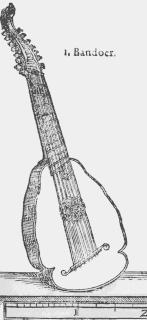
The bandora or bandore is a large long-necked plucked string-instrument that can be regarded as a bass cittern though it does not have the re-entrant tuning typical of the cittern. Probably first built by John Rose in England around 1560, it remained popular for over a century. A somewhat smaller version was the orpharion.
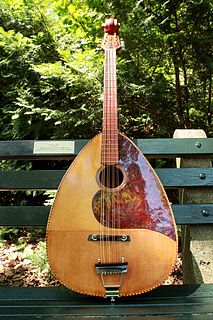
The mandocello is a plucked string instrument of the mandolin family. It is larger than the mandolin, and is the baritone instrument of the mandolin family. Its eight strings are in four paired courses, with the strings in each course tuned in unison. Overall tuning of the courses is in fifths like a mandolin, but beginning on bass C (C2). It can be described as being to the mandolin what the cello is to the violin.
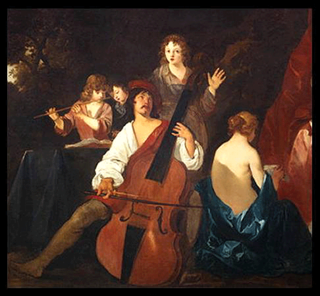
The term violone can refer to several distinct large, bowed musical instruments which belong to either the viol or violin family. The violone is sometimes a fretted instrument, and may have six, five, four, or even only three strings. The violone is also not always a contrabass instrument. In modern parlance, one usually tries to clarify the 'type' of violone by adding a qualifier based on the tuning or on geography, or by using other terms that have a more precise connotation. The term violone may be used correctly to describe many different instruments, yet distinguishing among these types can be difficult, especially for those not familiar with the historical instruments of the viol and violin families and their respective variations in tuning.

The mandolin-banjo is a hybrid instrument, combining a banjo body with the neck and tuning of a mandolin. It is a soprano banjo. It has been independently invented in more than one country, variously being called mandolin-banjo,banjo-mandolin,banjolin and banjourine in English-speaking countries, banjoline and bandoline in France, and the Cümbüş in Turkey.
In music, standard tuning refers to the typical tuning of a string instrument. This notion is contrary to that of scordatura, i.e. an alternate tuning designated to modify either the timbre or technical capabilities of the desired instrument.

The octave mandolin or octave mandola is a fretted string instrument with four pairs of strings tuned in fifths, G−D−A−E, an octave below a mandolin. It is larger than the mandola, but smaller than the mandocello and its construction is similar to other instruments in the mandolin family. Usually the courses are all unison pairs but the lower two may sometimes be strung as octave pairs with the higher-pitched octave string on top so that it is hit before the thicker lower-pitched string. Alternate tunings of G−D−A−D and A−D−A−D are often employed by Celtic musicians.
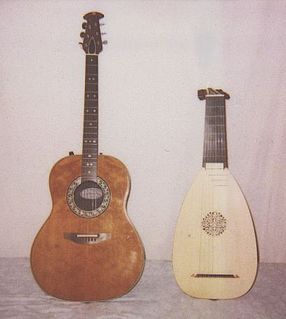
Plucked string instruments are a subcategory of string instruments that are played by plucking the strings. Plucking is a way of pulling and releasing the string in such a way as to give it an impulse that causes the string to vibrate. Plucking can be done with either a finger or a plectrum.

Mandobass is the largest member of the mandolin family, sometimes used as the bass instrument in mandolin orchestras. It is so large that it usually is not held in the lap, but supported on a spike that rests on the floor. The neck-scale length on a full-size mando-bass is similar to that of a standard orchestral double bass viol: about 43 inches (110 cm). The instrument is otherwise similar to the smaller, higher-pitched members of the mandolin family, having a fretted neck, a headstock with geared tuning machines, and a large resonating body often—but not always—shaped like that of other mandolins.
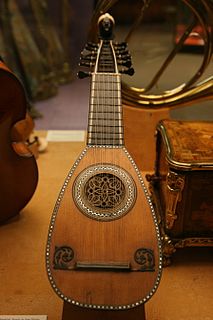
The mandore is a musical instrument, a small member of the lute family, teardrop shaped, with four to six courses of gut strings and pitched in the treble range. Considered a French instrument, with much of the surviving music coming from France, it was used across "Northern Europe" including Germany and Scotland. Although it went out of style, the French instrument has been revived for use in classical music. The instrument's most commonly played relatives today are members of the mandolin family and the bandurria.

A bridge is a device that supports the strings on a stringed musical instrument and transmits the vibration of those strings to another structural component of the instrument—typically a soundboard, such as the top of a guitar or violin—which transfers the sound to the surrounding air. Depending on the instrument, the bridge may be made of carved wood, metal or other materials. The bridge supports the strings and holds them over the body of the instrument under tension.
The octophone is a stringed musical instrument related to the mandola family resembling an octave mandolin. It was marketed by Regal Musical Instrument Company, who introduced it 21 January 1928, as an "eight-purpose instrument".

The Algerian mandole is a steel-string fretted instrument resembling an elongated mandolin, widely used in Algerian music such as Chaabi, Kabyle music and Nuubaat.

The mandolin is a modern member of the lute family, dating back to Italy in the 18th century. The instrument was played across Europe but then disappeared after the Napoleonic Wars. Credit for creating the modern bowlback version of the instrument goes to the Vinaccia family of Naples. The deep bowled mandolin, especially the Neapolitan form, became common in the 19th century, following the appearance of an international hit, the Spanish Students. They toured Europe and America, and their performances created a stir that helped the mandolin to become widely popular.
References
- 1 2 Lewin 1972, p. 143.
Reference bibliography
- Lewin, Robert (July 1972). de Sarasate, Pablo (ed.). "The Quintola". The Strad: A Monthly Journal for Professionals and Amateurs of All Stringed Instruments Played with the Bow. 83 (987): 143–147.
- http://stringedinstrumentdatabase.aornis.com/ Stringed Instrument Database